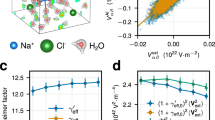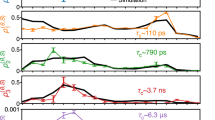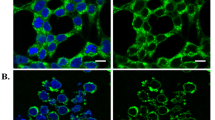Abstract
ATTEMPTS have recently been made to apply high resolution proton magnetic resonance spectrometry to the problem of molecular association in biological membranes and in dispersions of phospholipids in water1–4. On the high resolution scale, line broadening gives the appearance of weak absorption by protons of fatty acid molecules. Because broad lines could result from restricted molecular motion and might indicate that fatty acid chains are immobilized in these systems, a central problem in the interpretation of spectra is the relationship between molecular mobility and linewidth. In steady-state absorption nuclear magnetic resonance (NMR) the apparent transverse relaxation time, T2, is given by the reciprocal of the linewidth. Often the T2 thus obtained is an inverse measure of correlation time and reflects molecular mobility. This interpretation is valid for isotropic solutions of small molecules, where rapid motion produces line narrowing and large values of T2.
This is a preview of subscription content, access via your institution
Access options
Subscribe to this journal
Receive 51 print issues and online access
$199.00 per year
only $3.90 per issue
Buy this article
- Purchase on Springer Link
- Instant access to full article PDF
Prices may be subject to local taxes which are calculated during checkout
Similar content being viewed by others
References
Chapman, D., and Penkett, S. A., Nature, 211, 5055 (1966).
Chapman, D., Kamat, V. B., de Gier, J., and Penkett, S. A., Nature, 213, 74 (1967).
Chapman, D., Kamat, V. B., de Gier, J., and Penkett, S. A., J. Mol. Biol., 31, 101 (1968).
Steim, J. M., in Molecular Association in Biological and Related Systems, 84, 259 (Amer. Chem. Soc. Adv. Chem. Series, 1968).
Clifford, J., and Pethica, B. A., Trans. Faraday Soc., 60, 1483 (1964).
Steim, J. M., Edner, O. J., and Bargoot, F. G., Science, 162, 909 (1968).
Chapman, D., Leslie, R. B., and Hirz, R., Nature, 221, 260 (1969).
Penkett, S. A., Flook, A. G., and Chapman, D., Chem. Phys. Lipids, 2, 273 (1968).
Sheard, B., Nature, 223, 1057 (1969).
Zamir, D., and Cotts, R. M., Proc. Colloq. Ampère, 13, 276 (1964).
Drain, L. E., Proc. Phys. Soc. (London), 80, 1380 (1962).
Drain, L. E., J. Phys. Chem. Solids, 24, 379 (1963).
Zamir, D., and Cotts, R. M., Phys. Rev., 134, A666 (1964).
Zamir, D., Wayne, R. C., and Cotts, R. M., Phys. Rev. Lett., 12, 512 (1964).
Carr, H. Y., and Purcell, E. M., Phys. Rev., 94, 630 (1954).
Meiboom, S., and Gill, D., Rev. Sci. Instrum., 29, 688 (1958).
Dodge, J. T., Mitchell, C., and Hanahan, D. J., Arch. Biochem. Biophys., 100, 119 (1963).
Author information
Authors and Affiliations
Rights and permissions
About this article
Cite this article
KAUFMAN, S., STEIM, J. & GIBBS, J. Nuclear Relaxation in Phospholipids and Biological Membranes. Nature 225, 743–744 (1970). https://doi.org/10.1038/225743a0
Received:
Issue Date:
DOI: https://doi.org/10.1038/225743a0
This article is cited by
-
Structure of water in porous glass
Nature (1974)
-
Transverse Nuclear Relaxation in Lecithin Bilayers
Nature New Biology (1972)
-
Nuclear Relaxation Studies of Lecithin Bilayers
Nature (1971)
-
NMR Relaxation in Heterogeneous Systems
Nature (1970)
Comments
By submitting a comment you agree to abide by our Terms and Community Guidelines. If you find something abusive or that does not comply with our terms or guidelines please flag it as inappropriate.



